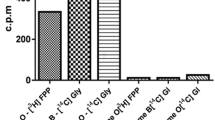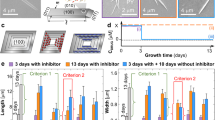Abstract
Background
Human falciparum malaria, caused by the intracellular protozoa Plasmodium falciparum, results in 1–2 million deaths per year. P. falciparum digests host erythrocyte hemoglobin within its food vacuole, resulting in the release of potentially toxic free heme. A parasite-specific heme polymerization activity detoxifies the free heme by cross-linking the heme monomers to form hemozoin or malaria pigment. This biochemical process is the target of the widely successful antimalarial drug chloroquine, which is rapidly losing its effectiveness due to the spread of chloroquine resistance. We have shown that chloroquine resistance is not due to changes in the overall catalytic activity of heme polymerization or its chloroquine sensitivity. Therefore, the heme polymerization activity remains a potential target for novel antimalarials. In this study, we investigated the ability of heme analogs to inhibit heme polymerization and parasite growth in erythrocytes.
Materials and Methods
Incorporation of radioactive hemin substrate into an insoluble hemozoin pellet was used to determine heme polymerization. Incorporation of radioactive hypoxanthine into the nucleic add of dividing parasites was used to determine the effects of heme analogs on parasite growth. Microscopic and biochemical measurements were made to determine the extent of heme analog entry into infected erythrocytes.
Results
The heme analogs tin protoporphyrin IX (SnPP), zinc protoporphyrin IX (ZnPP), and zinc deuteroporphyrin IX, 2,4 bisglycol (ZnBG) inhibited polymerization at micromolar concentrations (ZnPP ≪ SnPP < ZnBG). However, they did not inhibit parasite growth since they failed to gain access to the site of polymerization, the parasite’s food vacuole. Finally, we observed high ZnPP levels in erythrocytes from two patients with β-thalassemia trait, which may inhibit heme polymerization.
Conclusions
The heme analogs tested were able to inhibit hemozoin formation in Plasmodium falciparum trophozite extracts. The increased ZnPP levels found in thalassemic erythrocytes suggest that these may contribute, at least in part, to the observed antimalarial protection conferred by the β-thalassemia trait. This finding may lead to the development of new forms of antimalarial therapy.






Similar content being viewed by others
References
Nagel RL, Roth Jr EF. (1989) Malaria and red cell genetic defects. Blood 74: 1213–1221.
Gluzman IY, Francis SE, Oksman A, Smith CE, Duffin KL, Goldberg DE. (1994) Order and specificity of the Plasmodium falciparum hemoglobin degradation pathway. J. Clin. Invest 93: 1602.
Olliaro PL, Goldberg DE. (1995) The Plasmodium digestive vacuole: Metabolic headquarters and choice drug target. Parasitol Today 11: 294.
Slater AFG, Cerami A. (1992) Inhibition by chloroquine of a novel haem polymerase enzyme activity in malaria trophozoites. Nature 355: 167.
Chou AC, Fitch CD. (1992) Heme polymerase: Modulation by chloroquine treatment of a rodent malaria. Life Sci. 51: 2073.
Warhurst DC. (1995) Haemozoin and the mode of action of blood schizontocides: More controversy. Parasitol. Today 11: 204.
Dorn A, Stoffel R, Matile H, Bubendorf A, Ridley RG. (1995) Malarial haemozoin/betahaematin supports haem polymerization in the absence of protein. Nature 374: 269.
Bendrat K, Berger BJ, Cerami A. (1995) Haem polymerization in malaria. Nature 378: 138.
Slater AFG. (1993) Chloroquine: Mechanism of drug action and resistance in Plasmodium falciparum. Pharmacol. Ther. 57: 203.
Trager W, Jensen JB. (1976) Human malaria parasites in continuous culture. Science 193: 673.
Jensen JB, Trager W. (1977) Plasmodium falciparum in culture: Use of outdated erythrocytes and description of the candle jar method. J. Parasitol. 63: 883.
Lambros C, Vanderberg JP. (1979) Synchronization of Plasmodium falciparum erythrocytic stages in culture. J. Parasitol. 65: 418.
Desjardins RE, Canfield CJ, Haynes JD, Chulay JD. (1979) Quantitative assessment of antimalarial activity in vitro by a semiautomated microdilution technique. Antimicrob. Agents Chemother. 16: 710.
Piomelli S. (1972) A micromethod for free erythrocyte porphyrins: The FEP test. J. Lab. Clin. Med. 81: 932.
Piomelli S, Brickman A, Carlos E. (1976) Rapid diagnosis of iron deficiency by measurement of free erythrocyte porphyrins and hemoglobin: The FEP/Hemoglobin ratio. Pediatrics 57: 136.
Slater AFG, Swiggard WJ, Orton BR, et al. (1991) An iron-carboxylate bond links the heme units of malaria pigment. Proc. Natl. Acad. Sci. U.S.A. 88: 325.
Slater AFG. (1992) Malaria pigment. Exp. Parasitol. 74: 362.
Rodgers PA, Vreman HJ, Stevenson DK. (1990) Heme catabolism in rhesus neonates inhibited by zinc protoporphyrin. Dev. Pharmacol. Ther. 14: 216.
Kappas A, Drummond GS, Manola T, Petmezaki S, Valaes T. (1988) Sn-protoporphyrin use in the management of hyperbillrubinemia in term newborns with direct Coombs-positive ABO incompatibility. Pediatrics 81: 485–497.
Vreman HJ, Lee OK, Stevenson DK. (1991) In vitro and in vivo characteristics of a heme oxygenase inhibitor: ZnBG. Am. J. Med. Sci. 302: 335–341.
Vreman HJ, Rodgers PA, Stevenson DK. (1990) Zinc protoporphyrin administration 246 for suppression of increased bilirubin production by iatrogenic hemolysis in rhesus neonates. J. Pediatr. 117: 292.
Taraschi TF, Pouvelle B. (1994) There is no ducking the duct. Parasitol Today 10: 212.
Lyberatos C, Chalevelakis G, Platis A, Stathakis N, Panani A, Gardikas C. (1972) Erythrocyte content of free protoporphyrin in thalassaemic syndromes. Acta Haematol. 47: 164.
Han P, Fung KP, Teo CP, Tam LP. (1990) Alpha-thalassaemia and beta-thalassaemia traits: Biological difference based on red cell indices and zinc protoporphyrin. Clin. Lab. Haematol. 12: 169.
Hill AV, Flint J, Weatherall DJ, Clegg JB. (1987) Alpha-thalassaemia and the malaria hypothesis. Acta Haematol. 78: 173.
Flint J, Hill AV, Bowden DK, et al. (1986) High frequencies of alpha-thalassaemia are the result of natural selection by malaria. Nature 321: 744.
Stevenson DK, Rodgers PA, Vreman HJ. (1989) The use of metalloporphyrins for the chemoprevention of neonatal jaundice. Am. J. Dis. Child 143: 353.
Valaes T, Petmezaki S, Henschke C, Drummond GS, Kappas A. (1994) Control of jaundice in preterm newborns by an inhibitor of bilirubin production: Studies with tin-mesoporphyrin. Pediatrics 93: 1.
Elford BC, Ferguson DJP. (1993) Secretory processes in Plasmodium. Parasitol. Today 9: 80–84.
Goldberg DE, Slater AFG, Beavis R, Chait B, Cerami A, Henderson GB. (1991) Hemoglobin degradation in the human malaria pathogen Plasmodium falciparum: A catabolic pathway initiated by a specific aspartic protease. J. Exp. Med. 173: 961.
Goldberg DE, Slater AFG, Cerami A, Henderson GB. (1990) Hemoglobin degradation in the malaria parasite Plasmodium falciparum: An ordered process in a unique organelle. Proc. Natl. Acad. Sci. U.S.A. 87: 2931.
Pouvelle B, Spiegel R, Hsiao L, et al. (1991) Direct access to serum macromolecules by intraerythrocytic malaria parasites. Nature 353: 73.
Sherman IW, Zidovetzki R. (1992) A parasitophorous duct in Plasmodium-infected red blood cells. Parasitol. Today 8: 2.
Cannon JB, Martin C, Drummond GS, Kappas A. (1993) Targeted delivery of a heme oxygenase inhibitor with a lyophilized liposomal tin mesoporphyrin formulation. Pharm. Res. 10:715.
Luzzi GA, Torii M, Aikawa M, Pasvol G. (1990) Unrestricted growth of Plasmodium falciparum in microcytic erythrocytes in iron deficiency and thalassaemia. Br. J. Haematol. 74: 519–524.
Pasvol G, Wilson RJM. (1982) The interaction of malaria parasites with red blood cells. Br. Med. Bull. 38: 133.
Friedman MJ. (1979) Oxidant damage mediates variant red cell resistance to malaria. Nature 280: 245–247.
Brockelman CR, Wongsattayanont B, Tanariya P, Fucharoen S. (1987) Thalassemic erythrocytes inhibit in vitro growth of Plasmodium falciparum. J. Clin. Microbiol. 25: 56.
Nurse GT. (1979) Iron, the thalassemias, and malaria. Lancet Nov 3: 938–940.
Luzzi GA, Merry AH, Newbold CI, Marsh K, Pasvol G, Weatherall DJ. (1991) Surface antigen expression on Plasmodium falciparum-infected erythrocytes is modified in alpha- and beta-thalassemia. J. Exp. Med. 173: 785–791.
Carlson J, Nash GB, Gabutti V, Al-Yaman F, Wahlgren M. (1994) Natural protection against severe Plasmodium falciparum malaria due to impaired rosette formation. Blood. 84: 3909–3914.
Acknowledgments
We want to thank Gary Latortue for technical help and Dr. Patricia Griadino at the Pediatric Hematology Department of New York Hospital for the β-thalassemia blood samples. This work was supported by National Institutes of Health Grant RO1-AI-30660-04, Minority Individual in Postdoctoral Training Supplement Grant RO1-AI-30660-SI (JAM) and the UNDP/World Bank/WHO Special Program for Research in Tropical Diseases (AFGS).
Author information
Authors and Affiliations
Rights and permissions
About this article
Cite this article
Martiney, J.A., Cerami, A. & Slater, A.F.G. Inhibition of Hemozoin Formation in Plasmodium falciparum Trophozoite Extracts by Heme Analogs: Possible Implication in the Resistance to Malaria Conferred by the β-Thalassemia Trait. Mol Med 2, 236–246 (1996). https://doi.org/10.1007/BF03401620
Published:
Issue Date:
DOI: https://doi.org/10.1007/BF03401620




